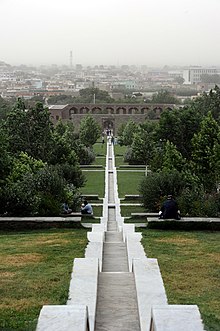Bagh-e Babur
The Bagh-e Babur , Garden of Babur ( باغ بابر), is a garden on a hill in the southwest of the old town of Kabul , which was laid out in 1528 during the reign of the first Mughal ruler Babur and served as his tomb. After its renovation, the garden has been on the candidate list of World Heritage Sites since 2009 .
investment
During the reign of Babur, buildings and gardens were built in his dominion in India, Iran and Afghanistan, which are called Tschahār Bāgh as a garden type . In Kabul, Babur had what was probably an existing structure converted into a garden of this type. After his death in 1530, Babur was transferred here from Agra in 1547 and an open tomb was erected for him. The tomb still existed in 1832 when Charles Masson drew it, it was destroyed in an earthquake in 1842 and then lost. The sarcophagus exhibited in the later replica is called the coffin of Babur.
The garden is about 11.5 hectares. It was laid out in 15 ascending terrace steps. The axis of the terrace system is oriented towards Mecca . The tomb is on the 14th terrace level. A tomb for Ruqaiya Sultan Begum , granddaughter of Babur and wife of Akbar I , was erected on the 15th level . 1645–46 a small, white mosque was built by Shah Jahan on the thirteenth level , he also had the water features renovated and a caravanserai built at the lower end. At the end of the 19th century, the Amir Abdur Rahman Khan had a seat built in the garden for his wife Bibi Halima and Europeanized the horticultural style. Bagh-e Babur was subject to structural changes in Kabul. In 1933 the garden was rededicated as a public park and various water basins and a water fountain were subsequently installed. A greenhouse and an outdoor pool were added in the 1970s. The population growth in Kabul ensured that urban development moved closer to the park walls.
The buildings, the plants and the plants in the garden were badly damaged by the war in Afghanistan after 1992.
The reconstruction measures since 2000 have been politically initiated by UN-HABITAT and organizationally and financially by the Aga Khan Foundation and the German and US diplomatic missions. The archaeological work is carried out by the German Archaeological Institute and the Afghan Archaeological Institute (AKTC). As part of the conservation work, the outer walls were restored between 2002 and 2004, and the renovation of the Shahjahan Mosque began in 2003. The Aga Khan Trust for Culture organized the replanting with trees and shrubs from the region.
literature
- Robin Lane Fox : Seeds of a greener Kabul. In: Financial Times , February 6, 2016, p. 24 link (en)
- D. Fairchild Ruggles: Islamic Gardens and Landscapes. Philadelphia, Pa. : University of Pennsylvania Press, 2008
- Warwick Ball: The Monuments of Afghanistan. History, Archeology and Architecture. London: IB Tauris-Verlag, 2008 ISBN 1-85043-436-0
- Ute Franke-Vogt, Thomas Urban: Bagh-e Babur: excavations November 2004 - June 2005. Berlin; Kabul: German Archaeological Institute; 2005.
- Robert Hillenbrand: Art and Architecture of Islam. Tübingen: Wasmuth, 2005
- Stephen F. Dale: The garden of the eight paradises: Bābur and the culture of Empire in Central Asia, Afghanistan and India (1483-1530). Leiden: Brill, 2004
- Ebba Koch : Mughal Architecture. Oxford: Oxford University Press, 2002
- Ebba Koch : Mughal Palace Gardens from Babur to Shah Jahan, 1526-1648 . In: Gülru Necipoglu (ed.): Muqarnas XIV: An Annual on the Visual Culture of the Islamic World. Leiden: EJ Brill, 1997, pp. 143-165.
- Salome Zajadacz-Hastenrath: A Note on Babur's Lost Funerary and Enclosure at Kabul. In: Gülru Necipoglu (ed.): Muqarnas XIV: An Annual on the Visual Culture of the Islamic World, Leiden: EJ Brill, 1997, pp. 135-142, at Jstor and at ArchNet
Web links
- Babur's Garden Rehabilitation Framework , at: Aga Khan Development Network, AKDN
- In pictures: Kabul's Moghul garden , at: BBC
- Bagh-e Babur Garden , at: orientalarchitecture
Individual evidence
- ↑ Bagh-e Babur , application text, at UNESCO World Heritage (en)
Coordinates: 34 ° 30 ′ 10 ″ N , 69 ° 9 ′ 30 ″ E







